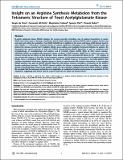Por favor, use este identificador para citar o enlazar a este item:
http://hdl.handle.net/10261/49058COMPARTIR / EXPORTAR:
 SHARE SHARE
 CORE
BASE CORE
BASE
|
|
| Visualizar otros formatos: MARC | Dublin Core | RDF | ORE | MODS | METS | DIDL | DATACITE | |

| Título: | Insight on an arginine synthesis metabolon from the tetrameric structure of yeast acetylglutamate kinase |
Autor: | Cima, Sergio de CSIC ORCID; Gil-Ortiz, Fernando CSIC ORCID; Crabeel, Marjolaine; Fita, Ignacio CSIC ORCID ; Rubio, Vicente CSIC ORCID | Fecha de publicación: | 18-abr-2012 | Editor: | Public Library of Science | Citación: | PLoS ONE 7(4):e34734 (2012) | Resumen: | N-acetyl-L-glutamate kinase (NAGK) catalyzes the second, generally controlling, step of arginine biosynthesis. In yeasts, NAGK exists either alone or forming a metabolon with N-acetyl-L-glutamate synthase (NAGS), which catalyzes the first step and exists only within the metabolon. Yeast NAGK (yNAGK) has, in addition to the amino acid kinase (AAK) domain found in other NAGKs, a ∼150-residue C-terminal domain of unclear significance belonging to the DUF619 domain family. We deleted this domain, proving that it stabilizes yNAGK, slows catalysis and modulates feed-back inhibition by arginine. We determined the crystal structures of both the DUF619 domain-lacking yNAGK, ligand-free as well as complexed with acetylglutamate or acetylglutamate and arginine, and of complete mature yNAGK. While all other known arginine-inhibitable NAGKs are doughnut-like hexameric trimers of dimers of AAK domains, yNAGK has as central structure a flat tetramer formed by two dimers of AAK domains. These dimers differ from canonical AAK dimers in the -110° rotation of one subunit with respect to the other. In the hexameric enzymes, an N-terminal extension, found in all arginine-inhibitable NAGKs, forms a protruding helix that interlaces the dimers. In yNAGK, however, it conforms a two-helix platform that mediates interdimeric interactions. Arginine appears to freeze an open inactive AAK domain conformation. In the complete yNAGK structure, two pairs of DUF619 domains flank the AAK domain tetramer, providing a mechanism for the DUF619 domain modulatory functions. The DUF619 domain exhibits the histone acetyltransferase fold, resembling the catalytic domain of bacterial NAGS. However, the putative acetyl CoA site is blocked, explaining the lack of NAGS activity of yNAGK. We conclude that the tetrameric architecture is an adaptation to metabolon formation and propose an organization for this metabolon, suggesting that yNAGK may be a good model also for yeast and human NAGSs. | Descripción: | 16 páginas, 9 figuras, 2 tablas. | Versión del editor: | http://dx.doi.org/10.1371/journal.pone.0034734 | URI: | http://hdl.handle.net/10261/49058 | DOI: | 10.1371/journal.pone.0034734 | E-ISSN: | 1932-6203 |
| Aparece en las colecciones: | (IBV) Artículos (IBMB) Artículos |
Ficheros en este ítem:
| Fichero | Descripción | Tamaño | Formato | |
|---|---|---|---|---|
| Insight.pdf | 5,03 MB | Adobe PDF |  Visualizar/Abrir |
CORE Recommender
PubMed Central
Citations
11
checked on 10-abr-2024
SCOPUSTM
Citations
17
checked on 15-abr-2024
WEB OF SCIENCETM
Citations
16
checked on 28-feb-2024
Page view(s)
312
checked on 16-abr-2024
Download(s)
252
checked on 16-abr-2024
Google ScholarTM
Check
Altmetric
Altmetric
Artículos relacionados:
NOTA: Los ítems de Digital.CSIC están protegidos por copyright, con todos los derechos reservados, a menos que se indique lo contrario.
